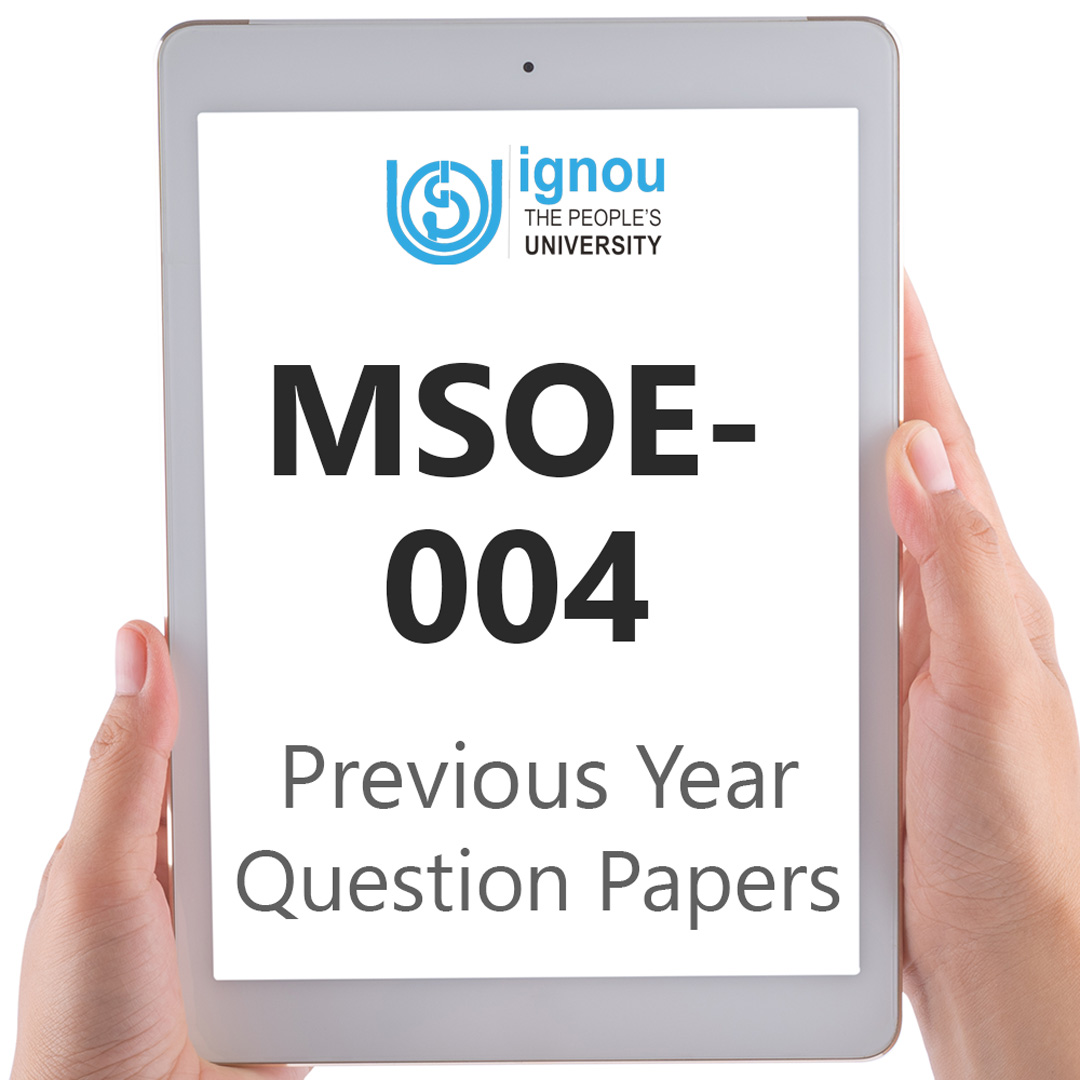If you are looking for MSOE-004 IGNOU Solved Assignment solution for the subject Urban Sociology, you have come to the right place. MSOE-004 solution on this page applies to 2022-23 session students studying in MSO courses of IGNOU.
MSOE-004 Solved Assignment Solution by Gyaniversity
Assignment Code: MSOE-004/AST/TMA/2022-23
Course Code: MSOE-004
Assignment Name: Urban Sociology
Year: 2022-2023
Verification Status: Verified by Professor
Answer any five-question selecting at least two from each Section. Your answer should be in about 500 words each.
Section-I
Q1) Describe the ecological park theory with suitable examples.
Ans) The emphasis is on Park's theories and research regarding social inequalities within this framework. Richard Helmes-Hayes, the author, asserts that Park's theory has significantly influenced sociology, however Park's theory is much more general and less precisely defined than other ideas. Numerous others also contend that Park's idea eventually fell short of addressing social inequalities. It is clear from reading the essay that many of Park's opinions clashed with one another and were strongly affected by other human ecologists. Despite the shortcomings in Park's methodology, Helmes-Hayes contends that many people fail to recognise that Park's theory does investigate social injustice.
The main ideas of the ecology theory are the convictions that social disparity in society is comprised of and best described by two social orders. The first is the ecological order, which consists of unintended, mutually beneficial interactions, and a moral order, which consists of conscious meaning and willed institutions. The other four fundamental ideas are conflict, domination, rivalry, and social inequity. Human ecologists created the interaction cycle as a technique to analyse and ascertain the structure and purpose of any civilization they may be researching.
The interaction cycle consists of these four elements. Competition, conflict, accommodation, and assimilation make up these components. When there is an unplanned, global struggle for survival, competition results. Every living thing contains it. Conflict starts when a group or groups realise that they are vying for the same resources. Once a problem is settled, accommodation is made. Assimilation takes place when a new order is established, and all groups develop into it.
Although there is no explicit definition of what plant ecology is, there is a distinction made between it and human ecology. According to Park, plant ecology contains the sole true kind of biotic competition. This is so because plants aren't mindful of or aware of their competition with other plants or other living things. A population that is congregated in a certain region and competing for resources is said to live in a community. A society exists when there is a relationship between institutionalised human groupings. When there are social orders or levels with a rating, there is a hierarchy.
Social Darwinism is based on four major principles. The first is that inequality is normal and will always exist. Second, to uphold laissez-faire principles, social Darwinism supports conservative politicians and corporate leaders. Thirdly, Social Darwinism may be found in nature and is biological. Fourth, Social Darwinism supports the functionalism theory.
Social issues arise when people are unable to swiftly adapt to city living, which leads to social disorganisation. If something were uncommon among the middle class or in a certain area, human ecologists would frequently label it as abnormal. Human ecologists have also used social disorganisation to explain issues like crime and social deviance. The functionalist theory and the ecology theory mesh best. This is due to the theory's extensive list of causes for social inequality, which nevertheless includes explanations of each cause's role in society.
Q2) Define the concept of city and discuss the town/city distinction according to the Indian Census.
Ans) Very few sociological words have consensus definitions among specialists. The idea of a city is no different. We run into a lot of issues while describing the city that are well-known to sociologists. In his article on the city: Forms and Functions in the International Encyclopaedia of Social Sciences, Mumford also makes reference to this fact. He writes that while cities as a form of human settlement date back to the dawn of civilization, they have long escaped scholarly scrutiny and that their very definition is still up for debate.
The term city would be likewise subject to Levi-Strauss' critique of the totemic ambiguities, though with less justification given that the city has experienced several transformations without losing its institutional and architectural continuity. Everyone appears to understand what a city is, yet no one has provided a complete definition. Due to the lack of a clear vocabulary in English to separate the progression of urban forms from infant to adult, German is the language that best captures their purely quantitative nature. Regional city and regional urban grid are potential emerging forms, and Eopolis, polis, metropolis, megalopolis, and conurbation have been proposed as analogous series in English.
Town/City According to Indian Census
It is evident from the definition given below that the census of India combined legal, population, occupation, and density while defining urban/town:
1) In all locations where there is a municipality, corporation, cantonment board, or informed town area committee, etc.
2) All additional locations that met the following requirements:
a) A minimum of 5,000 people.
b) At least 75% of working males must be engaged in non-agricultural activities, and this criterion has also been applied in many other contexts. Confusion arises since the criteria is sometimes defined as 75% of the working population and 75% of the adult male population.
c) A population density of at least 400 people per square kilometre.
Between 1981 and 1991, the definition above received a small modification. The urban criteria used in the Censuses of 1981 and 1991 were somewhat different from those used in 1961 and 1971. When determining the male working population engaged in non-agricultural pursuits, the workers in non-agricultural occupations such as forestry, fishing, livestock, hunting, logging, plantations, and orchards were treated as non-agricultural in the 1961 and 1971 Censuses but as agricultural in the 1981 and 1991 Censuses. Additionally, the 1991 Census did away with the discretion of the Census Directors to consider some locations as having unique urban features even though they did not strictly meet all of the requirements listed under category (b) above, and the 2001 Census has continued to use this discretion.
Q3) What are pre-industrial cities? Describe and discuss its features with an example.
Ans) Social scientists have given the term pre-industrial cities to describe those cities in Asia and Africa that did not develop as a result of a production method connected to the European industrial revolution. It is distinguished by a tight class structure, a highly developed governmental or religious system, and a sophisticated social organisation.
Ecological Organisation
Pre-industrial cities primarily function as market hubs and rely on imported food and raw materials for their survival. These facilities also produce a variety of handicrafts. These cities host significant religious, political, and educational events. The temple priests and officials have access to a number of resources in this way. A range of governmental, commercial, or religious tasks are carried out by city dwellers. In such a metropolis, several class divisions are evident. There could be various spaces designated for various portions, and these spaces might be separated by a wall. Even the various vocational groups live separately. Members of a specific trade or craft are frequently concentrated on a certain street or area of the city.
Economic Organisation
Pre-industrial cities have different economies from industrial ones. The absence of industrialism is the primary distinction. Industrialism is described as a form of production where more is produced using inanimate or non-living sources of power. Pre-industrial towns rely on live sources of energy used directly or indirectly through mechanical tools like hammers, pulleys, and wheels to produce commodities and services. Electricity and steam are used in industrial civilizations, which enhances productivity. This type of manufacturing, which necessitates the creation of numerous organisations, alters the social, economic, and ecological structure of industrial cities.
The distinctive manufacturing system of the pre-industrial metropolis is another feature of it. There isn't any work specialisation or fragmentation. The handicraftsmen engaged in almost every stage of an item's manufacturing and carried out the work in his own home or in a small business nearby, as long as it complied with local guild and community laws. They also retained control over the production processes. In pre-industrial cities, the majority of commercial operations are likewise carried out by individuals without a highly formalised organisation.
Social Organisation
There is a distinct class structure as well as distinct family, religious, governmental, and educational systems. The most remarkable feature is a literate elite that both controls and is reliant on the populace, as is the case with the caste system in India. People who occupy leadership positions in the government, as well as in societal institutions like religion and education, make up the elite. The majority primarily serves the privileged by producing handicrafts and other services. The upper class and lower class are clearly separated from one another, but there are also many levels within each of these classes. Elite families enjoy wealth and power for their members. The sacred writings support their position.
Groups that are on the margins or are considered outcasts and are not fundamental to the prevailing social structure play a vital role. In India, the lower castes, or untouchables, offer the upper castes a variety of services. They are inferior to the urban lower class and carry out particularly degrading jobs like burying the dead. In pre-industrial cities, an organised system of age grading serves as a means of control. The oldest son in a household is given privileges. Youth and children are viewed as inferior to parents and other adults. In society, older people have a great deal of prestige and authority.
Section-II
Q1) How has the occupational structure changed after economic liberalization, privatization, and globalization in urban India.
Ans) The initial research reveals a drop in the period's work participation rate. In the age range of 45 and older, the greatest WPR drop is seen. On the other hand, the proportion of women in urban India who are working has climbed. It has been discovered that skilled manual labour is the most common form of job in urban India, regardless of the size of the city. In major/capital cities, it is 11.2%, in smaller cities, 14.0%, and in towns, 12.7%. The second most common occupation is that of merchants, shop owners, and wholesale and retail commerce, which is almost equally prevalent everywhere.
In comparison to smaller Indian towns, large cities have a higher share of clerical and related workers. 10.3% of the workforce is comprised of skilled manual labourers, followed by unskilled employees and labourers. Administrative, executive, and managerial occupations account for 6.5 percent of all principal occupations, and medical professionals make up 2.1 percent. About 1.3 percent of all workers in metropolises in India are architects and engineers, compared to less than 1% in agriculture and related fields.
The differences in employment opportunities by caste, religion, and sex are, nonetheless, extremely clear. Domestic workers are the most common form of employment for women in India's major cities, followed by secretaries and other related occupations. Additionally, female employment is more prevalent in households with low standards of living. By caste and religion, there are differences in job patterns. When compared to other occupations, a sizable share of Schedule Tribe's working population is employed in low-paying jobs. On the other hand, it is discovered that Muslims outnumber Hindus in certain professions such skilled manual merchants, retailers, and trade regardless of the type of urban region, however this is not the case for administrative, executive, management, teachers, and clerical and associated employment.
According to the analysis, regardless of the kind of urban locality, such as a capital/large city, small city, or towns, and regardless of sex, there is a fall in WPR among older age groups in the late reform phase. For lower age groups, however, the same is not true. The difference in WPR between different types of urban locales revealed that while it has slightly decreased or remained steady in big cities and capital cities, the total WPR has noticed ably increased in minor cities and towns. Both in the ERP and LRP, the female WPR has increased, but higher among women who are illiterate and have less education. With regard to the households' standard of living index, a comparable difference is seen.
In urban India, about 25% of the labour force is employed in low-paying employment, compared to fewer than 10% in high-paying jobs. However, compared to small cities and towns, the proportion of the labour force working in low-paying jobs is significantly smaller in large/capital cities. The gender disparity in employment by type of metropolitan locations further demonstrated that more working women in metropolises are employed as domestic employees. Teachers are the occupation that women perform the most, followed by skilled manual work. The difference in occupational patterns by caste group demonstrated the wide range of employment by caste. While a higher percentage of ST and SCs than others work in low-paying jobs In Urban India, there is a similar difference in occupation patterns based on religion.
Q2) Which is more acute-urban poverty or rural poverty in India? Discuss critically with examples.
Ans) Because the degree of urbanisation is more strongly correlated with general measures of economic development than with particular indicators relating to industrialization or urbanisation, structural changes and poverty analyses are accelerating. In fact, the two cannot be viewed independently given their tight association with the severity of rural poverty. This is hardly surprising given the relatively significant labour mobility. If conditions in rural areas are significantly worse, an increase in urban welfare will inevitably attract job seekers from those places.
Urban activities are essentially unrestricted, and urban labour markets likely have more of a national flavour than rural ones. Rural production is also less likely to vary widely between states since it is more clearly rooted in an immovable asset land. In comparison to output and value added, the employment structure has changed at a far slower rate. Manufacturing has expanded rapidly, but possibly not quickly enough. Contrary to what is commonly believed, manufacturing employment, not the tertiary sector, has been the sector with the quickest rate of growth. There is substantial evidence of an accelerated change in the employment structure as well.
Up until the middle of the following decade, the trend of industrial dispersal appears to have been stronger. Even while there is a typically positive association between manufacturing activity and urban poverty, it is difficult to claim that industrial dispersal had any substantial impact on eradicating urban poverty based on the evidence. The east-west division is basically where the main regional pattern arises. Bihar, MP, Orissa, UP, Tamil Nadu, and Orissa are the states with chronically high poverty rates in both rural and urban areas. High levels of rural poverty are also seen in West Bengal and Maharashtra, two developed states.
Urbanization in these states increased dramatically at the same time as all of these changes. Consequently, agricultural expansion is essential to reducing urban poverty. Without corresponding increases in agricultural productivity, strong growth rates in manufacturing activity and employment are difficult to maintain. The evidence from the older industrialised states is unmistakable: despite high levels of industrialization and urbanisation, poverty elimination in these states is hampered by lingering hinterlands. The development of non-agricultural activities in rural areas as well as small and medium towns whose main purpose is the servicing of their hinterland would be the most affected by the effect of increased agricultural growth.
The functioning of the labour market and increased demand from small and medium towns for their goods and services have an indirect impact on big cities. The biggest issue is revealed to be the eastern region's degradation. In terms of eradicating poverty, the approach of placing heavy industries in the eastern and central states hasn't had much success. A large portion of Bihar, MP, Orissa, UP, Andhra Pradesh, and Karnataka have agricultural regions that are very low in productivity. Their rates of industrialization and urbanisation are among the lowest in the world, yet they also have some of the highest poverty indexes.
Without a large direct assault on agricultural output, industrial dispersal will have little impact on reducing urban or rural poverty in these regions. All the data points to a gradual overall structural shift as the source of India's modest reduction in poverty. The distribution of heavy and large industry rather than farm and light industries was the goal of the investment plan, which suggests that the employment structure has changed considerably more slowly than value generated. Only if the investment strategy is oriented toward a far more expedited development of non-agricultural employment can a self-sustaining plan for poverty elimination in urban and rural areas be reached.





